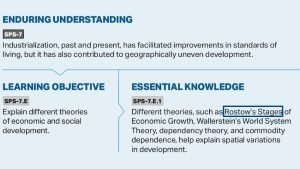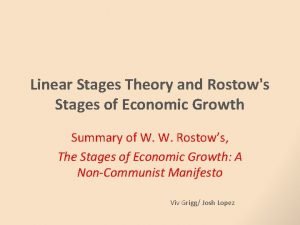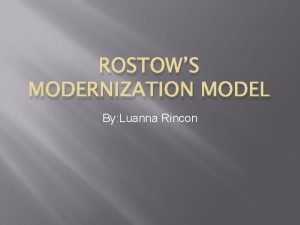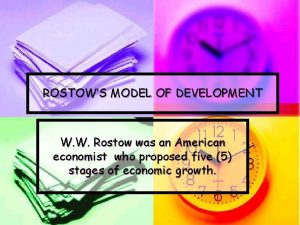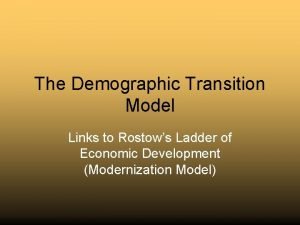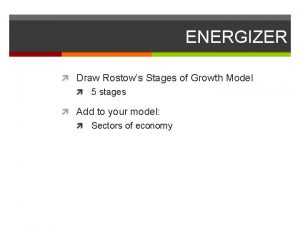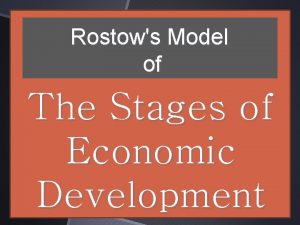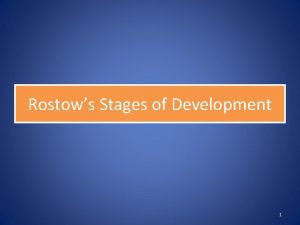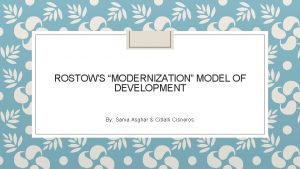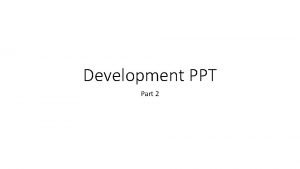Rostows Stages of Growth Rostows Stages of Growth












- Slides: 12


Rostow’s Stages of Growth

Rostow’s Stages of Growth Match the description with the correct stage: a) Traditional Society - b) Preconditions for Take-Off - c) Take-Off - d) Drive to Maturity - e) Age of Mass-Consumption - f) Beyond Consumption ___1. Manufacturing shifts from investment-driven (capital goods) towards consumer durables and domestic consumption ___2. Development of more productive, commercial agriculture and cash crops not consumed by producers and/or largely exported ___3. the industrial base dominates the economy; the primary sector is of greatly diminished weight in the economy and society ___4. limited technology ___5. consumers typically (if not universally), have disposable income, beyond all basic needs, for additional goods ___6. Urbanization increases, industrialization proceeds, technological breakthroughs occur ___7. age of diminishing relative marginal utility as well as an age for durable consumer goods ___8. Rapid development of transportation infrastructure ___9. No centralized nations or political systems ___10. Americans feel as if they were born into a society that has high economic security and high consumption ___11. External demand for raw materials initiates economic change ___12. "Secondary" (goods-producing) sector expands and ratio of secondary vs. primary sectors in the economy shifts quickly towards secondary ___13. a stage where its merely speculation on whethere is further consumer diffusion or what the new generation will bring for growth ___14. characterized by subsistence agriculture or hunting and gathering; almost wholly a "primary" sector economy ___15. Diversification of the industrial base; multiple industries expand new ones take root quickly ___16. Textiles and apparel are usually the first "take-off" industry, as happened in Great Britain's classic "Industrial Revolution" ___17. Development of national identity and shared economic interests

Traditional Society Preconditions for Take-Off Drive to Maturity Age of Mass. Consumption Take-Off limited technology Development of more productive, commercial agriculture and cash crops not consumed by producers and/or largely exported Urbanization increases, industrialization proceeds, technological breakthroughs occur No centralized nations or political systems External demand for raw materials initiates economic change characterized by subsistence agriculture or hunting and gathering; almost wholly a "primary" sector economy Development of national identity and shared economic interests Manufacturing shifts from investmentdriven (capital goods) towards consumer durables and domestic consumption the industrial base dominates the economy; the primary sector is of greatly diminished weight in the economy and society age of diminishing relative marginal utility as well as an age for durable consumer goods "Secondary" (goods- Rapid development producing) sector of transportation expands and ratio of infrastructure secondary vs. primary sectors in the economy shifts quickly towards secondary. consumers typically (if not universally), have disposable income, beyond all basic needs, for additional goods Americans feel as if they were born into a society that has high economic security and high consumption Textiles and apparel are usually the first "take-off" industry, as happened in Great Britain's classic "Industrial Revolution" Urban society (a movement away from rural countrysides to the cities) a stage where its merely speculation on whethere is further consumer diffusion or what the new generation will bring for growth Diversification of the industrial base; multiple industries expand new ones take root quickly Beyond Consumption

1. Manufacturing shifts from investment-driven (capital goods) towards consumer durables and domestic consumption 2. Development of more productive, commercial agriculture and cash crops not consumed by producers and/or largely exported. 3. the industrial base dominates the economy; the primary sector is of greatly diminished weight in the economy and society 4. limited technology 5. consumers typically (if not universally), have disposable income, beyond all basic needs, for additional goods 6. Urbanization increases, industrialization proceeds, technological breakthroughs occur. 7. age of diminishing relative marginal utility as well as an age for durable consumer goods 8. Rapid development of transportation infrastructure. 9. No centralized nations or political systems. 10. Americans feel as if they were born into a society that has high economic security and high consumption 11. External demand for raw materials initiates economic change. 12. "Secondary" (goods-producing) sector expands and ratio of secondary vs. primary sectors in the economy shifts quickly towards secondary. 13. a stage where its merely speculation on whethere is further consumer diffusion or what the new generation will bring for growth 14. characterized by subsistence agriculture or hunting and gathering; almost wholly a "primary" sector economy 15. Diversification of the industrial base; multiple industries expand new ones take root quickly 16. Textiles and apparel are usually the first "take-off" industry, as happened in Great Britain's classic "Industrial Revolution" 17. Development of national identity and shared economic interests. 18. Urban society (a movement away from rural countrysides to the cities) Source: https: //en. wikipedia. org/wiki/Rostow%27 s_stages_of_growth

Rostow’s Stages of Growth


According to dependency theory, underdevelopment is mainly caused by the peripheral position of affected countries in the world economy. Typically, underdeveloped countries offer cheap labour and raw materials on the world market. These resources are sold to advanced economies, which have the means to transform them into finished goods. Underdeveloped countries end up purchasing the finished products at high prices, depleting the capital they might otherwise devote to upgrading their own productive capacity. The result is a vicious cycle that perpetuates the division of the world economy between a rich core and a poor periphery.



ore (C) countries, two Semi-periphery (SP) countries, and two P C- Core SP - Semi-periphery P- Perihery Country SP Brazil P Peru C Australia C Germany P Indonesia SP Argentina C United States C Japan P Nigeria SP India SP South Africa P Kenya

 Rostows stages of growth
Rostows stages of growth Linear stages theory
Linear stages theory Take-off-teorin innebär att
Take-off-teorin innebär att Conclusion of modernization
Conclusion of modernization Ww rostow model
Ww rostow model Dtm ladder
Dtm ladder Difference between organic and inorganic growth
Difference between organic and inorganic growth What is plant growth analysis
What is plant growth analysis Vascular ray
Vascular ray Eudicot
Eudicot Geometric growth vs exponential growth
Geometric growth vs exponential growth Step growth polymerization vs chain growth
Step growth polymerization vs chain growth Neoclassical growth theory vs. endogenous growth theory
Neoclassical growth theory vs. endogenous growth theory
